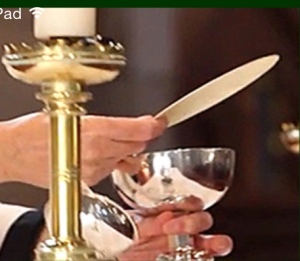It’s TV Premiere Season!! The happiest time of the year! And there’s no show return I have been anticipating more enthusiastically than Sleepy Hollow.
In this re-telling of Washington Irving’s classic tale, Ichabod Crane is a British soldier during the American Revolution, who became a turn-coat spy working under George Washington. In the course of events, he and a Hessian mercenary fatally wound one another in battle. Only, as it turns out, Ichabod’s wife Katrina is a witch (naturally), who joins Ichabod’s blood to that of the Hessian (spoiler–he becomes the headless horseman). As a result Ichabod finds himself resurrected 250 years later when the former Hessian/now Horseman re-emerges to bring about the end of the world. Because (naturally) the Headless Horseman is also the first horseman of the Apocalypse. So, Ichabod and unsuspecting Sleepy Hollow police detective Abbie Mills find themselves battling the forces of evil. Oh yes … I also forgot to mention that they find a prophecy in George Washington’s bible that they are the two witnesses foretold in the book of Revelation. Because … of course they are!
And that’s all just the first episode! Suffice it to say this show is *ridiculous* and only gets more insane from that point on. By all accounts, this series should have utterly flopped after its debut last season. At yet … it became one of the break out hits of last season. Based on Leeman’s skeptical blank stare over coffee this morning as I attempted to explain certain elements of the second season premiere, I’d say odds look good that the momentum keeps going.
It may seem odd, but I do believe there two very important lessons that we as the church can learn from this little show that could.
First: Walking the Walk and not just Talking the Talk when it comes to race and gender issues.
Sleepy Hollow is one of the most racially progressive shows on TV. Not only does it feature a tough (though realistically flawed) woman of colour as one of its two main leads, the show devotes significant time to the relationship between Lieutenant Mills and her sister Jenny, as well as the family dynamics impacting police Captain Frank Irving (played by Orlando Jones). Korean actor John Cho shows up as the recurring villain/anti-hero Andy Brooks, rounding out the diverse cast. Meanwhile, Ichabod’s wife Katrina enjoys significant agency, possessing far greater knowledge of events than her husband and, indeed, being the person who initially sets series events in motion. One could argue a straight white male (Tom Mison) is still at the centre of the cast; however, he is also the marginalized “other.” Indeed, the only prominent white characters are the Crane family–Ichabod, Katrina, and their son played by John Nobel (who, yes, is far older than his parents — did I mention this show is ridiculous?)–each of whom inhabits a space outside what might be considered normative. It is a fascinating dynamic, one which works against the deeply ingrained conservatism of the entertainment industry.
Much like Hollywood, we in more progressive Christian streams talk a good talk about wanting to push forward on issues of inclusivity and awareness around gender/racial issues. But how often do we walk the walk in subtle ways that really matter? The church, for all its greatness, is still a heavy institution and fundamental change happens very slowly. So many of the most prominent Christian voices are still mostly white (and largely male). It is easy for people of privilege within the church (among whom I count myself) to talk about the importance of inclusivity, but so much harder to step back, make ourselves less and give space to more diverse voices. Often, if we’re honest, we don’t even know how to get started on that. The always insightful Rachel Held Evans notes that true racial progress in the church means that those of us with privileged platforms must challenge ourselves: to listen more, to educate ourselves, and to believe that such change is actually needed–which it desperately is if we are to build the kingdom of heaven here on earth.
And second: Stop being embarrassed of / apologizing for ourselves
As I mentioned, Sleepy Hollow is far better than it has any right to be. Historical inaccuracies? Who cares! Overly contrived plot twists? Yes please! Zombie George Washington? I’m sure it’s only a matter of time!
Why can Sleepy Hollow get away with such nonsense? Because the show just embraces its own absurdity. It never apologizes for itself. It is what it is. And because it plays every twist and turn (no matter how extraordinary) with a completely straight face, the cast and crew are able to have genuine moments of humour and tenderness between the grounded and loveable characters.
I have to believe there is a lesson in there somewhere for the church. So often, it seems that we are ashamed of who were are and what we believe. We are embarrassed by our own traditions. Our evangelistic strategy seems to be assuring people “Don’t worry — we’re not as bad as you think!”
On one level, I get it. Christianity is weird. It might honestly make LESS sense than the plot of Sleepy Hollow. The whole Virgin Birth gets a little tricky to explain. And the Trinity is a bit of a head-scratcher. Then we have the whole problem of a theology of the cross affirming the paradox of triumph and resurrection that can only be known to us through Jesus’s suffering and death. We might even be understandably embarrassed by the church itself–lets be honest, we have a checkered past, to say the least.
All the same, we must believe there is some GOOD NEWS to our faith. We must believe there is something worth pursuing in this Christian endeavour at the end of the day. We have the story of a God who is deeply involved and engaged with his creation. A God of radically inclusion–in whom there is no division of gender, race, or social class. It is amazing stuff. It is well worth embracing and (I dare say) even proclaiming. And for all the church’s foibles, it offers us a rich tradition of devotion, wisdom, and artistic expression that connects us to our forerunners in faith throughout the centuries.
I wonder what we might be able to get away with and achieved if we just shamelessly embraced everything our faith and our tradition had to offer. Without apologizing or making excuses. If it works for a TV show, why wouldn’t it work for the church?


